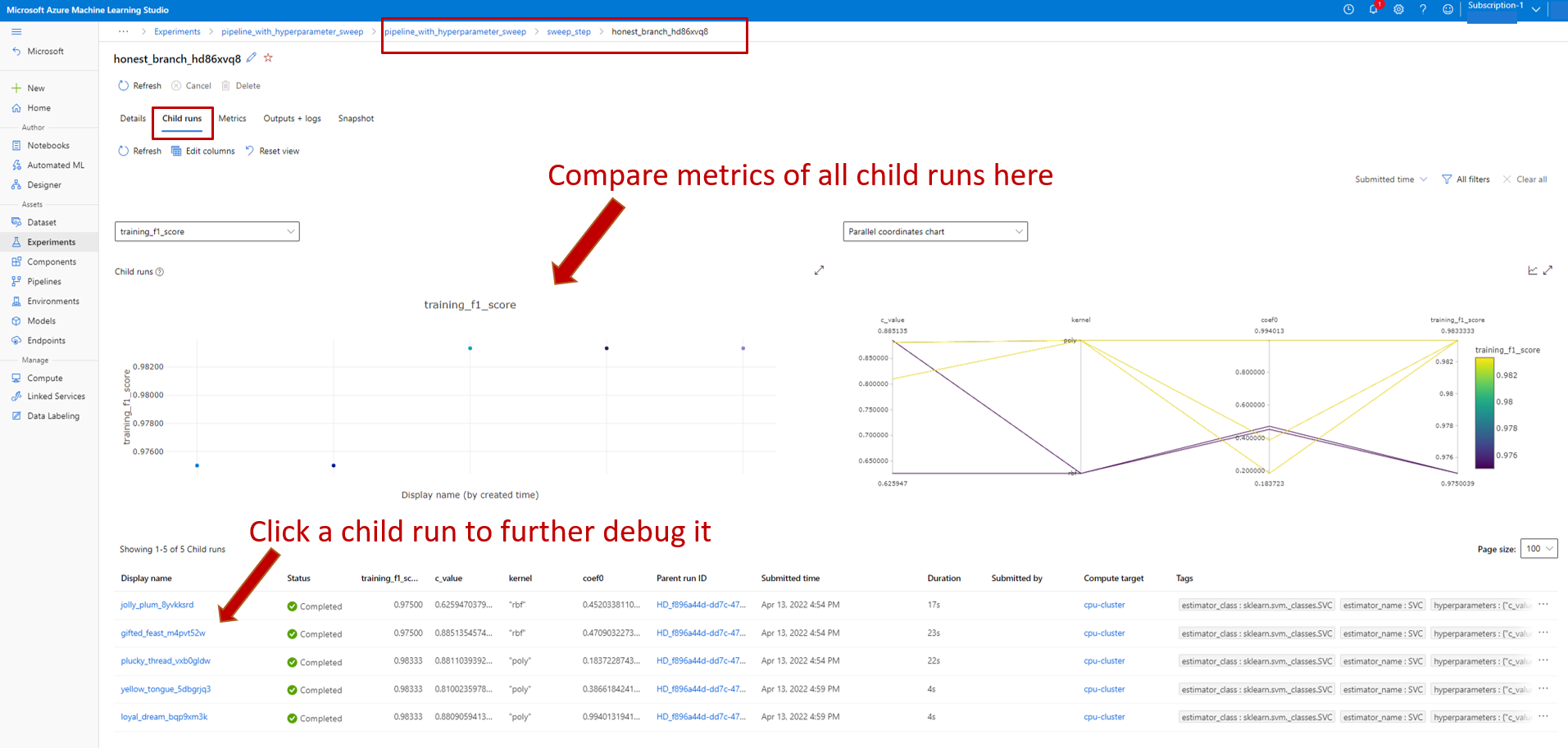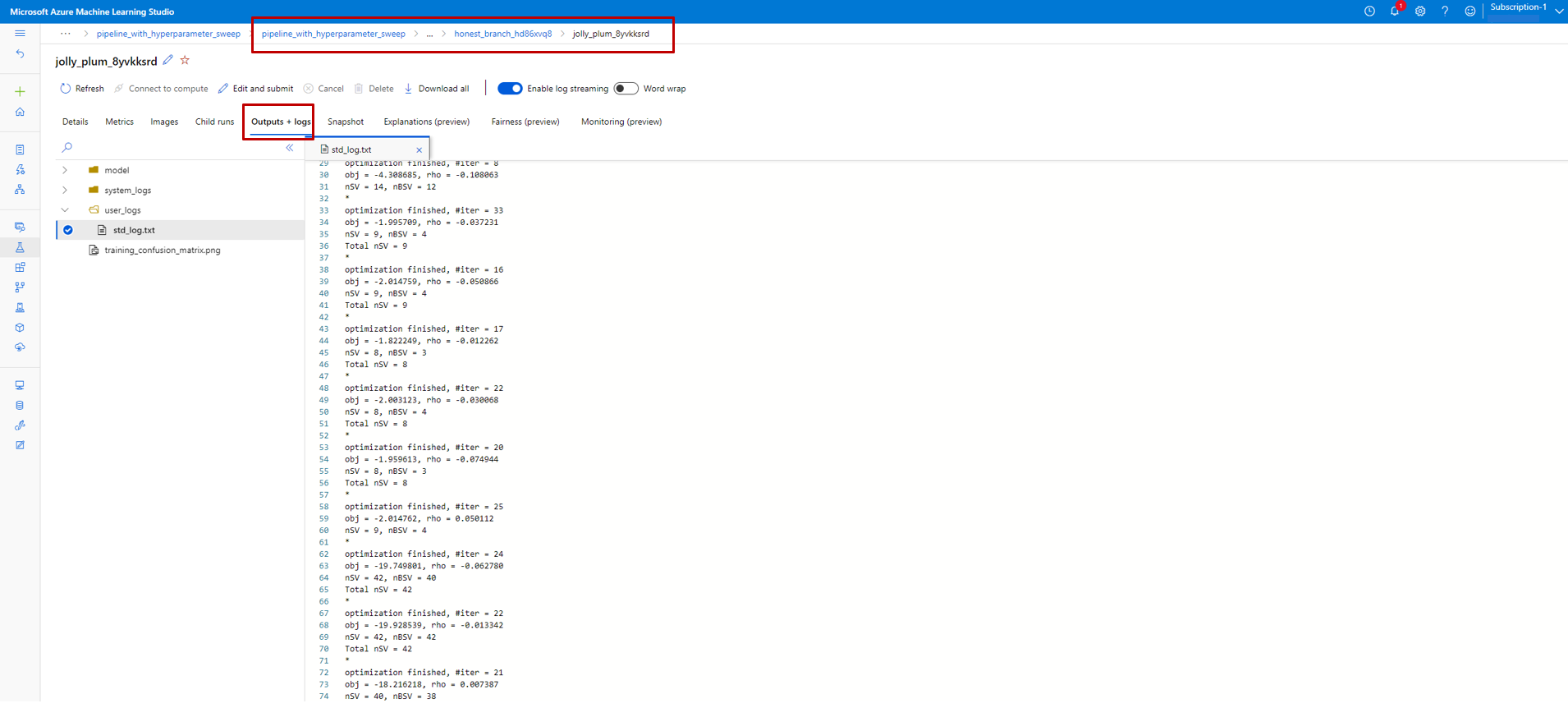适用范围: Azure CLI ml 扩展 v2(最新版)
Azure CLI ml 扩展 v2(最新版) Python SDK azure-ai-ml v2(最新版)
Python SDK azure-ai-ml v2(最新版)
在本文中,你将学习如何使用 Azure 机器学习 CLI v2 或适用于 Python 的 Azure 机器学习 SDK v2 在 Azure 机器学习管道中自动执行超参数优化。
超参数是可调整的参数,可用于控制模型训练过程。 超参数优化是确定能够获得最佳性能的超参数配置的过程。 Azure 机器学习使你能够自动执行超参数优化,并且并行运行试验以有效地优化超参数。
先决条件
- 有一个 Azure 机器学习帐户和工作区。
- 了解 Azure 机器学习管道和对模型进行超参数优化。
创建并运行超参数优化管道
以下示例来自 Azure 机器学习示例存储库中的在管道中使用扫描 (hyperdrive) 运行管道作业。 有关使用组件创建管道的详细信息,请参阅在 Azure 机器学习 CLI 中使用组件创建并运行机器学习管道。
创建具有超参数输入的命令组件
Azure 机器学习管道必须有一个带有超参数输入的命令组件。 示例项目中的以下 train.yml 文件定义了一个 trial 组件,该组件具有 c_value、kernel 和 coef 超参数输入并运行位于 ./train-src 文件夹中的源代码。
$schema: https://azuremlschemas.azureedge.net/latest/commandComponent.schema.json
type: command
name: train_model
display_name: train_model
version: 1
inputs:
data:
type: uri_folder
c_value:
type: number
default: 1.0
kernel:
type: string
default: rbf
degree:
type: integer
default: 3
gamma:
type: string
default: scale
coef0:
type: number
default: 0
shrinking:
type: boolean
default: false
probability:
type: boolean
default: false
tol:
type: number
default: 1e-3
cache_size:
type: number
default: 1024
verbose:
type: boolean
default: false
max_iter:
type: integer
default: -1
decision_function_shape:
type: string
default: ovr
break_ties:
type: boolean
default: false
random_state:
type: integer
default: 42
outputs:
model_output:
type: mlflow_model
test_data:
type: uri_folder
code: ./train-src
environment: azureml://registries/azureml/environments/sklearn-1.5/labels/latest
command: >-
python train.py
--data ${{inputs.data}}
--C ${{inputs.c_value}}
--kernel ${{inputs.kernel}}
--degree ${{inputs.degree}}
--gamma ${{inputs.gamma}}
--coef0 ${{inputs.coef0}}
--shrinking ${{inputs.shrinking}}
--probability ${{inputs.probability}}
--tol ${{inputs.tol}}
--cache_size ${{inputs.cache_size}}
--verbose ${{inputs.verbose}}
--max_iter ${{inputs.max_iter}}
--decision_function_shape ${{inputs.decision_function_shape}}
--break_ties ${{inputs.break_ties}}
--random_state ${{inputs.random_state}}
--model_output ${{outputs.model_output}}
--test_data ${{outputs.test_data}}
创建试用组件源代码
此示例的源代码是单个 train.py 文件。 此代码在扫描作业的每次试用中执行。
# imports
import os
import mlflow
import argparse
import pandas as pd
from pathlib import Path
from sklearn.svm import SVC
from sklearn.model_selection import train_test_split
# define functions
def main(args):
# enable auto logging
mlflow.autolog()
# setup parameters
params = {
"C": args.C,
"kernel": args.kernel,
"degree": args.degree,
"gamma": args.gamma,
"coef0": args.coef0,
"shrinking": args.shrinking,
"probability": args.probability,
"tol": args.tol,
"cache_size": args.cache_size,
"class_weight": args.class_weight,
"verbose": args.verbose,
"max_iter": args.max_iter,
"decision_function_shape": args.decision_function_shape,
"break_ties": args.break_ties,
"random_state": args.random_state,
}
# read in data
df = pd.read_csv(args.data)
# process data
X_train, X_test, y_train, y_test = process_data(df, args.random_state)
# train model
model = train_model(params, X_train, X_test, y_train, y_test)
# Output the model and test data
# write to local folder first, then copy to output folder
mlflow.sklearn.save_model(model, "model")
from distutils.dir_util import copy_tree
# copy subdirectory example
from_directory = "model"
to_directory = args.model_output
copy_tree(from_directory, to_directory)
X_test.to_csv(Path(args.test_data) / "X_test.csv", index=False)
y_test.to_csv(Path(args.test_data) / "y_test.csv", index=False)
def process_data(df, random_state):
# split dataframe into X and y
X = df.drop(["species"], axis=1)
y = df["species"]
# train/test split
X_train, X_test, y_train, y_test = train_test_split(
X, y, test_size=0.2, random_state=random_state
)
# return split data
return X_train, X_test, y_train, y_test
def train_model(params, X_train, X_test, y_train, y_test):
# train model
model = SVC(**params)
model = model.fit(X_train, y_train)
# return model
return model
def parse_args():
# setup arg parser
parser = argparse.ArgumentParser()
# add arguments
parser.add_argument("--data", type=str)
parser.add_argument("--C", type=float, default=1.0)
parser.add_argument("--kernel", type=str, default="rbf")
parser.add_argument("--degree", type=int, default=3)
parser.add_argument("--gamma", type=str, default="scale")
parser.add_argument("--coef0", type=float, default=0)
parser.add_argument("--shrinking", type=bool, default=False)
parser.add_argument("--probability", type=bool, default=False)
parser.add_argument("--tol", type=float, default=1e-3)
parser.add_argument("--cache_size", type=float, default=1024)
parser.add_argument("--class_weight", type=dict, default=None)
parser.add_argument("--verbose", type=bool, default=False)
parser.add_argument("--max_iter", type=int, default=-1)
parser.add_argument("--decision_function_shape", type=str, default="ovr")
parser.add_argument("--break_ties", type=bool, default=False)
parser.add_argument("--random_state", type=int, default=42)
parser.add_argument("--model_output", type=str, help="Path of output model")
parser.add_argument("--test_data", type=str, help="Path of output model")
# parse args
args = parser.parse_args()
# return args
return args
# run script
if __name__ == "__main__":
# parse args
args = parse_args()
# run main function
main(args)
注释
请确保将指标记录在试用组件源代码中,其名称应与管道文件中的 primary_metric 值完全相同。 此示例使用 mlflow.autolog(),这是推荐用来跟踪机器学习试验的方法。 有关 MLflow 的详细信息,请参阅使用 MLflow 跟踪 ML 试验和模型。
创建包含超参数扫描步骤的管道
对于 train.yml 中定义的命令组件,以下代码创建一个两步 train 和 predict 管道定义文件。 在 sweep_step 中,必需的步骤类型为 sweep,c_value 组件的 kernel、coef 和 trial 超参数输入将添加到 search_space。
以下示例突出显示了超参数优化 sweep_step。
$schema: https://azuremlschemas.azureedge.net/latest/pipelineJob.schema.json
type: pipeline
display_name: pipeline_with_hyperparameter_sweep
description: Tune hyperparameters using TF component
settings:
default_compute: azureml:cpu-cluster
jobs:
sweep_step:
type: sweep
inputs:
data:
type: uri_file
path: wasbs://datasets@azuremlexamples.blob.core.windows.net/iris.csv
degree: 3
gamma: "scale"
shrinking: False
probability: False
tol: 0.001
cache_size: 1024
verbose: False
max_iter: -1
decision_function_shape: "ovr"
break_ties: False
random_state: 42
outputs:
model_output:
test_data:
sampling_algorithm: random
trial: ./train.yml
search_space:
c_value:
type: uniform
min_value: 0.5
max_value: 0.9
kernel:
type: choice
values: ["rbf", "linear", "poly"]
coef0:
type: uniform
min_value: 0.1
max_value: 1
objective:
goal: minimize
primary_metric: training_f1_score
limits:
max_total_trials: 5
max_concurrent_trials: 3
timeout: 7200
predict_step:
type: command
inputs:
model: ${{parent.jobs.sweep_step.outputs.model_output}}
test_data: ${{parent.jobs.sweep_step.outputs.test_data}}
outputs:
predict_result:
component: ./predict.yml
有关完整的扫描作业架构,请参阅 CLI (v2) 扫描作业 YAML 架构。
提交超参数优化管道作业
提交此管道作业后,Azure 机器学习会多次运行 trial 组件,以基于你在 sweep_step 中定义的搜索空间和限制扫描超参数。
在工作室中查看超参数优化结果
提交管道作业后,SDK 或 CLI 小组件会提供指向 Azure 机器学习工作室 UI 中的管道图的 Web URL 链接。
若要查看超参数优化结果,请双击管道图中的扫描步骤,在详细信息面板中选择“子作业”选项卡,然后选择子作业。
在子作业页上,选择“试用”选项卡以查看和比较所有子运行的指标。 选择任何子运行以查看该运行的详细信息。
如果子运行失败,则可以在子运行页上选择“输出 + 日志”选项卡以查看有用的调试信息。


